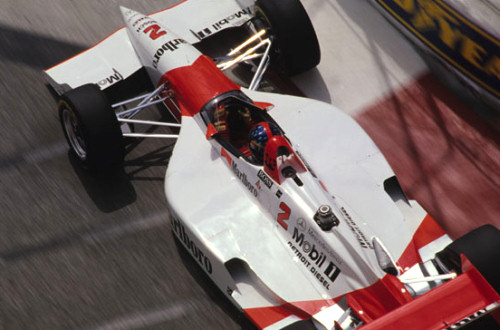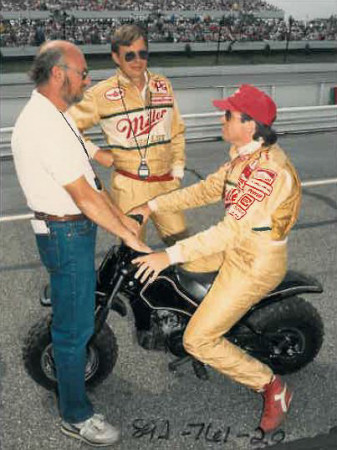Nigel Bennett's prescription for improving open-wheel racingby Gordon Kirby |
 Last week's column about the rise of aerodynamics as the controlling element in modern motor racing brought plenty of murmuring agreement. Everyone thinks the use of wind tunnels should be restricted and the aero influence on the cars reduced. The most complete response by far came from Nigel Bennett who's been thinking about these problems for some time.
Last week's column about the rise of aerodynamics as the controlling element in modern motor racing brought plenty of murmuring agreement. Everyone thinks the use of wind tunnels should be restricted and the aero influence on the cars reduced. The most complete response by far came from Nigel Bennett who's been thinking about these problems for some time.
Nigel is one of the world's most experienced racing car designers. After starting his career in the seventies as a Firestone tire engineer he enjoyed a twenty year stretch designing Formula One and Indy cars. In his formative days Bennett worked as a tire engineer with many of the top Formula 1 teams, Ferrari and Lotus included, and was a race engineer at Lotus when Mario Andretti won the World Championship in 1978. Bennett moved on to design F1 cars for Ensign and Theodore before turning his hand to Indy cars with Lola. His first Lola Indy car--the T84/00--was an instant success as Andretti won his fourth Indy car championship aboard a Newman/Haas T84/00 in 1984. Andretti won six races and Danny Sullivan won three more races in another Lola run by Doug Shierson's team. Over the next three years Bennett-designed Lola Indy cars won another dozen races. All these cars were elegant, attractive machines and the '87 Lola was particularly effective as Andretti dominated the month of May at Indianapolis before suffering a late-race engine failure while Bobby Rahal won his second CART championship driving a T87/00 run by Jim Trueman's Truesports team.  © Racemaker/Paul Webb A longtime boating and yachting enthusiast Bennett does some boat design work these days to keep him occupied in his retirement. He's also kept his hand in the racing business by doing some technical consulting work for the FIA and published his autobiography, 'Inspired to Design' in 2013. Few people enjoy such impeccable motor racing credentials and it would serve the sport well to think about and consider adopting Bennett's recommendations for making big cuts in downforce and tire grip to produce a better show in F1 and Indy car racing. I first discussed Nigel's ideas with him in this space in December of 2013. I also wrote a column for Motor Sport early last year with a brief overview of his concept. In response to last week's column Nigel emailed me the specific details of his proposal. Here they are: The Problems: The Solutions: Tires:The above changes would drastically reduce braking performance by reducing the energy that could be put into the front tires, and increase traction. If the tire manufacturer could be persuaded to make rear tires that produce their maximum cornering force at a greater slip angle, that would make the cars more spectacular to watch and show driver skill levels to a greater degree. Reduce downforce: To further explain Nigel's ideas here are some highlights from his conversation in this space from December, 2013. "In my opinion," Bennett says, "they need to reduce downforce by 50 percent, reduce the front tire and wheel width by 20 percent and increase the rear tire width by 10 percent. They also need to free up the weight distribution rules and change the tire construction so that the tires produce their maximum cornering force at much higher slip angles than the current radials. "I suspect this would mean going back to bias or cross-ply tires as they were in the '70s and '80s. The driver's skill would be on view as the cars would drift and braking distances would be much longer and cornering speeds much lower so that overtaking would be more frequent.  © Racemaker/Dennis Torres "I think the reason the cars used to be so much more spectacular was largely due to the type of tires. Cross-ply tires made for bigger slip angles and more sliding than we have today with radial tires. "People say we can't go back to cross-ply tires, but why not? Formula One persuaded Pirelli to build tires that wear out after ten laps, which is not good for their public image. So surely you can ask a tire company to build smaller, cross-ply tires. I'm sure they've got the technology to do it. The cars would be more spectacular to watch and I would also suggest they would be a greater test of the drivers' skills." Bennett emphasizes that extreme cost is F1's biggest problem. "The main problem with Formula One is that it's just too expensive for all but about four teams," he says. "I have to say that what goes on inside some of these big teams is absolutely ludicrous. There are drawing offices going off into the distance as far as you can see with eighty or ninety people working away at computer screens. "The cars are incredibly complicated. They're beautifully made but unbelievably complicated with all kinds of stuff that's largely unnecessary and unappreciated by the fans and media. It makes for paying jobs for the young engineers but as far as the general public is concerned I don't think there's much interest in that. It's just jobs for the young engineers to spend the money they've been given but I don't think there's much interest in that to the general public. "Look at the front wings with all the little bits and pieces stuck on them. And for what? Yes, they're producing phenomenal aerodynamic performance figures but none of that stuff bares any relation to anything else in the world and it doesn't look nice. "Airplanes don't have bits like that stuck all over them. They're sleek, the way racing cars used to be, and there's no place for that kind of stuff on road cars. It's just jobs for the boys to spend the money they've been given." Bennett says F1 is unable to make major changes because of the need for unanimity under the Concorde Agreement. "It's not easy to get people to agree. They've all invested millions of dollars in wind tunnel testing and aerodynamic work and they don't want to lose the advantages they've gained. "They've talked endlessly for some years about cost reduction but that seems to have fallen by the wayside. In fact, I've been involved in some of those discussions and the problem is nobody trusts anybody else to do it properly.  © LAT USA Bennett believes narrower tires and reduced downforce would also be a benefit to IndyCar. "There's been a lot of criticism over recent years about Indy cars having too much downforce and too little power so that they run closely together on some tracks so you get pack racing which is very dangerous on a track where they're flat-out all the way around whether it's a one-mile oval or a banked track like NASCAR. "To me, a reduction in tire size would be very effective for IndyCar in these circumstances. The cornering speeds would be less, the straightaway speeds would be greater and at a stroke it would break up the field and allow it to open up a bit so there would be more passing and racing. "If you reduce the tire sizes by fifteen percent then the compounds have to get harder to withstand the temperature. Straightaway speeds would go up because the drag would be reduced and you would get braking into the corners because the apex speed would be lower. It's one way out of this problem that's never been suggested." Bennett's words are very clear and directly to the point. If either Formula 1 or Indy car racing are going to thrive in the future they surely need to listen to and implement his ideas. |
|
Auto Racing ~ Gordon Kirby
Copyright ~ All Rights Reserved |
